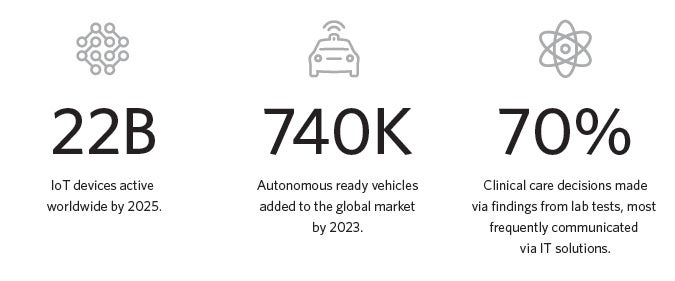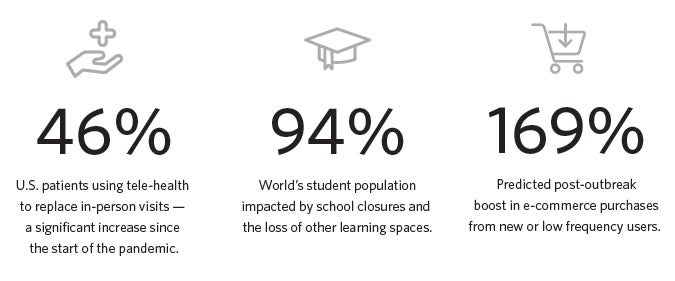
Approaches to Designing Edge Data Center Ecosystems
We have all heard the superlatives, “Digital Age,” “Industry 4.0,” and “App Economy.” But what do they really mean to the world we live in, the companies we work for, and our families at large? At no time in our history has data been developed at this rate. The time for exponential data growth is being measured in seconds, not years. And this was true even prior to the COVID-19 pandemic.

- IOT Analytics predicts there will be over 22 Billion IoT devices worldwide by 2025.
- Gartner predicts more than 740,000 autonomous ready vehicles will be added to the global market by 2023.
- According to the Centers for Disease Control, 70% of current decisions made in patient care can be accredited to laboratory tests. IT has made the process of communication quicker and more accurate.
Now, the COVID-19 pandemic has forced many organizations, companies and civic agencies to become even more dependent on online capabilities:

- According to the American Medical Association, 46% of patients are now using telehealth services to replace in-person visits — a significant increase since the start of the pandemic.
- According to a United Nations report, 94% of the world’s student population (nearly 1.6 billion) have been impacted by school closures and the loss of other learning spaces.
- Accenture predicts a 169% boost in e-commerce purchases from new or low frequency users post-outbreak.
These figures are only the tip of the technology iceberg affecting governments, markets, industries, and life as we know it. From telehealth treatments to a greater urgency for remote learning capabilities, the reoccurring element in all of these various systems is data collection, processing, and distribution. But they have something else in common — they are all dependent on low-latency (processing times in the sub-100 millisecond level) capabilities. This means that some, if not all, of the processing required for these systems to work properly will be dependent on near or on-premises computer interaction. This is what edge processing data centers are all about.
There are several overall approaches which can be taken to develop these systems:
Modify Existing Systems – Many organizations already have distributed networks which handle data traffic, however these systems are likely set up for slower technologies along the network and little or no intelligence in the systems themselves. Upgrades to pipelines to allow larger chunks of data to move, allowances for computing to occur in non-traditional spaces not usually reserved for IT equipment (e.g., stores, warehouses, roadside sites, etc.), and considerations for site protection and integrity of continuous operations all need to be examined, evaluated, and addressed.
Partnering with Vendors – There are a number of edge system vendors who are offering systematic approaches to creating an edge data center eco-system. Care needs to be taken in matching an organization’s needs with the vendor’s potential solution. These systems can provide a unified approach to solve edge data center needs when a well-developed system plan is in place. However, if that plan is not completely vetted, there can be some difficulty in finding off-the-shelf solutions that fit without requiring extra modifications. A partner at the table who has understanding from both the vendor and the organization’s system point of view can be a valuable ally in making sure the best interests and needs are addressed. It is also important to have an understanding of where things will go down the road relating to either an organization’s changing needs or their potential growth, as well as to make sure there is fiscal, environmental, and future planning capabilities built into the system chosen and committed to.
Creation of a New System Topology and Infrastructure – With some organizations, the best approach will be to start from scratch to address what they need from an edge data center system. This will require the development of a system topology, investigations of site locations (for both existing and new sites being considered), concept planning, design development (including prototyping and IT integration), construction oversight and systems testing. Those organizations with strong industry leadership and expansive ecosystems in place may seek this approach to create something more customized to their specific needs. This may also play into their own technical R&D which may aid in supporting the specific type of edge data center system required for their deployment needs. Partnering with a firm who can understand the parameters required, propose innovative solutions, and advance them into actionable systems will be key to making a successful edge data center systems come to life.
Over the past three blogs, we have reviewed the edge data center's role in connecting across industries, society, and every day interactions. We looked at how edge data centers work. And we highlighted different strategies that companies or institutions can undertake for improving or building a new edge data center ecosystem. The next step is to develop a thoughtful, well-planned strategy for deploying Edge Data Center improvements that considers the latest innovations different industries are seeing out in the world today and anticipates changes to come down the road. Doing so will pay dividends in a future that will be ever-more connected. As we all face truly unique challenges moving forward, there has never been a more crucial moment to examine, plan, and execute a strategy for the integration of technology that allows maximum flexibility, remote capabilities, and the ability to handle data needs in a low-latency manner to best process and disperse for your organizations needs. We hope this series has helped provide a better roadmap to understanding how Edge Systems and their associated physical spaces can help achieve that goal.
This is the third and final blog in our series An Edge on the Future: Preparing for the Edge Data Center Surge, where we explore why edge data centers are important, the elements that go into the design of edge data center systems and how they increase the ability to retrieve, send, and process information, and how changes to communications with the development of 5G, gigabit Wi-Fi and the fourth industrial revolution are affecting how these systems will function.
Current Events Impacting Your Tech Needs?
As our dependence on virtual communication and collaboration has greatly increased, our reliance on many of the systems highlighted in this blog has been catapulted to the forefront of our daily lives. If your organization or company is seeking advice on how to roll-out, maintain, or upgrade your edge system, we have the experience and expertise to provide support or guidance.
tom.widawsky [at] hdrinc.com (CONTACT US)


